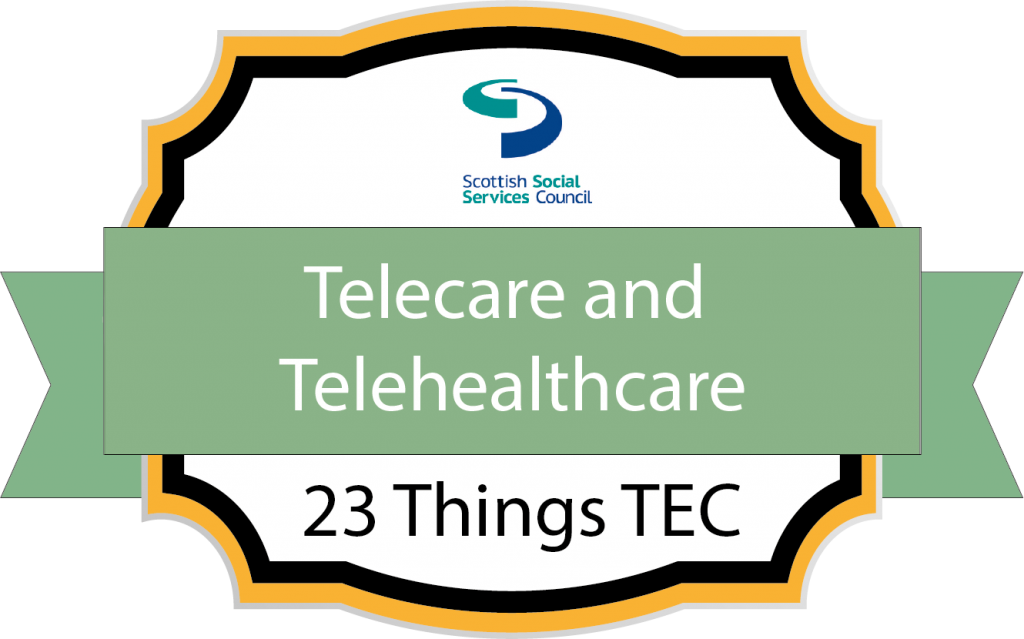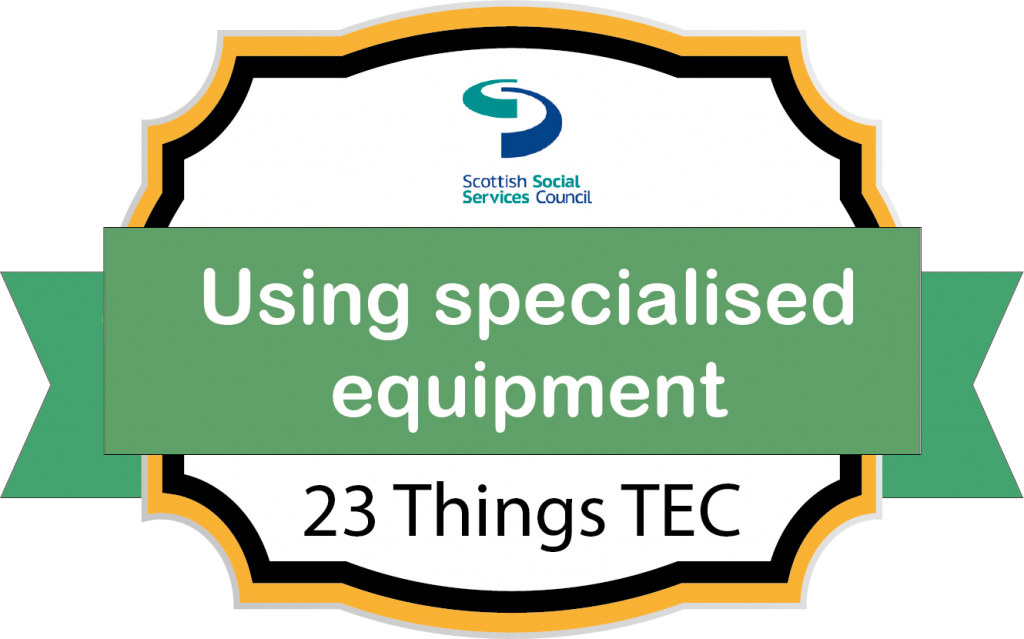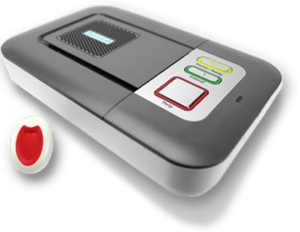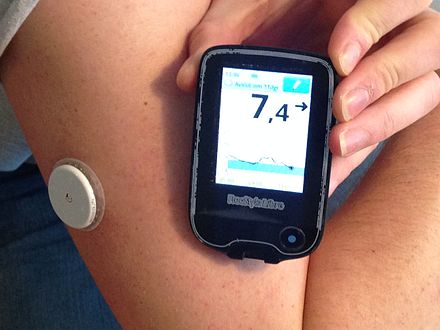Open badge information
Open badge: SSSC 23 Things TEC – Thing 6: Telecare and Telehealthcare

Counts toward the Using specialised equipment badge.

Introduction

Telecare is a way of delivering care and support services at a distance using technology. This enables people to remain more independent in their own homes rather than stay in supported accommodation or residential care. For example, many people can live in their own homes because they have been given sensors that can detect when they may have fallen. These sensors trigger alarms that summon help and support when required, which avoids the need to stay in residential care.
Telehealthcare is like telecare but covers remote health services and communication relating to health. This can help people using health services avoid the need to travel to hospital or GP surgeries for routine monitoring of things like blood pressure or blood/sugar levels. It also enables people to speak to their GP remotely using video calls. For example, in Scotland we have a system called ‘Near me’ that enables people to speak directly to health professionals using video.
In the years before the Covid pandemic, easier access to mobile technology combined with falling prices led to an increase in the use of technology to support care. This accelerated during the pandemic due to the need to provide services remotely as far as we could. Most of us are now familiar with having appointments with health services like GPs online and there appears to be a growing expectation and demand for the option to do this going forward. This is just one example of how technology can help to meet the care and support needs of people using services. You can find out more about the NHS remote appointments system ‘Near Me’ by watching the video below. Just click on the arrow box in the centre of the video to start.
How does technology support tele care and telehealthcare?
The technology used for telecare varies from simple devices like pressure mats to sophisticated wireless monitoring systems that include ‘wearables’. You can find out more about wearables in Thing 10.
At the time of writing, there is a major change happening in the way that technology is used to support telecare. From 2023, copper-based telephone lines are being switched off and being replaced by ways of making telephone calls using the internet called Internet Protocol. Some offices and workplaces already use this, however many people are still using analogue land lines in their homes for telephone services, which will need to be replaced. You can find out more about the switch from analogue to digital telephone communications on the ‘Future of voice’ webpage.
One aspect of this change over that we must all consider is that the new landlines will rely on broadband routers which require electrical power to work. This means that if there is a power cut, telecare and telehealthcare services will not work without some kind of power backup eg. a battery. This also applies to calls to emergency services so if you don’t know already, you must check how your service will support people in their own homes during power cuts.
Mobile devices such as smartphones, digital tablets (like iPads) and laptops mean that people do not need to have large computers in their homes to use telecare and telehealthcare services. This makes these services are far more accessible for people living the community.
Learning Activity 1
Please watch the ‘What is telecare?’ video by clicking on this link What is telecare? And make notes about the following:
- What were the benefits for each of the people using services?
- Which of the scenarios could relate to your role (if you are currently working in a care role) or to your own circumstances?
- Based on what you watched, what benefits could there be for services who use telecare?
Please keep your written notes as you will need to attach them if you want to apply for the MyLearning badge relating to telecare and telehealthcare.
How could using tele care and telehealthcare affect your role?
We know that some workers feel anxious about using technology as part of the care and support provided to people using services. This can be for a variety of reasons including fear of breaking expensive equipment, being concerned they won’t understand how to use it and that technology will remove the ‘personal touch’ when providing care and support. These concerns are valid and understandable, however there is support for workers to help them overcome these anxieties and we must all realise that we cannot avoid using technology to some degree in our roles.
Always remember that technology should always be used to enhance, but not replace, care and support that someone needs. Telecare and telehealthcare will not meet the needs of every person using services so should not be applied in a blanket approach but in an individual way based on a care assessment recorded in a care plan.
While technology can enhance care and support, we must remember that even the most reliable devices and equipment may fail. This is why you have an important role in observing the person using the service and report anything that does not appear to be right, even if the device or equipment says it is. Never assume that what a device shows or does is right and you are wrong, or that information will always be sent to remote monitoring sites so always raise any concerns.

Creative Commons licence CC BY-SA 4.0
For example, you are supporting a Mrs Campbell who has been diagnosed with Type 1 Diabetes. When you go to see her, you notice that although her room is not hot, she is sweating, says she feels a bit ‘shakey’ and is also a bit irritable, which is unusual. You are aware from training that these signs could indicate that she may have a low blood/sugar level, so you suggest that she checks the remote monitor that she wears to see what her level is. The monitor sends information about her blood/glucose level to a remote monitoring site where trained workers can be alerted if the levels are too low. Mrs Campbell does this and the reading is within the acceptable range.
It might be tempting to think everything is fine, however you must remember that the reader may not have been calibrated correctly or low battery power may affect the accuracy of the reading, also it relies on a good wifi connection to send the information to the remote monitor. Ignoring you own observations and relying on the feedback from the monitor could affect Mrs Campbell’s wellbeing and health, so you must report what you have observed and seek guidance about what you should do from her care plan or your line manager.
Learning Activity 2
Like all aspects of your role, you must feel prepared and confident to use technology to ensure that people using services get the best possible experience from telecare and telehealthcare. Please think about how prepared and confident you currently are and write a short note about this. Your note will not be seen by anyone that you do not choose to share it with, so you can be as open as you like.
Once you have reflected on your current level of skill and confidence, please make a note of what you feel would improve these. Please remember that everyone starts from having different levels of skill and confidence, so there are no right or wrong answers to what you need to support you and it may help you to have a discussion with your line manager about any training and learning that you need to do.
Please keep your notes as you will need to attach these to your MyLearning badge application. (Please remember that only people that you choose to share this badge with will see your notes attached to your application).